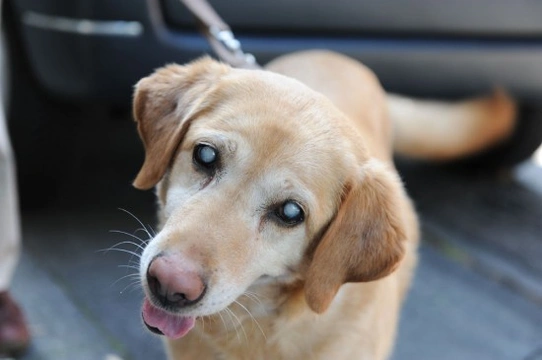
Cataracts in dogs
A cataract refers to clouding of the eye’s lens, which can lead to problems with vision. As with people, cataracts are one of the most common causes of blindness in dogs, and cataracts are particularly prevalent in older dogs, where they occur as a side effect of aging. Small cataracts and those in the initial stages of development will be unlikely to interfere greatly with vision, however, cataracts can grow and develop, and so it is important to be aware of the signs of a cataract developing, and how to monitor its growth.
Do you know how to tell if your dog is having problems with his vision or developing cataracts, plus what to do if you suspect a problem? Read on to learn more.
More about cataracts
Cataracts manifest within the eye over time when yellowish-brown pigment becomes deposited within the lens of the eye, which disrupts the normal construction of the lens fibre. This leads to a reduction in the amount of light that reaches the cones of the eyes, causing a range of problems such as loss of good colour differentiation, and due to the general obscuring of the lens, loss of general vision. Dogs with cataracts are particularly likely to have problems seeing well in dim environments and at night, although very bright lights can cause glare that again, makes it difficult for them to see well. Cataracts may be present in either one or both eyes, and finding cataracts in both eyes is not uncommon.
What kind of dogs are prone to contracting cataracts?
Any dog of any breed or age can theoretically develop cataracts, although it does often accompany ageing and is most commonly seen in mature dogs over the age of eight, with the likelihood of cataract occurrence increasing exponentially each year. Cataracts can, however, be present from birth, and may manifest in young dogs between birth and three years old.
Some specific breeds of dogs are also rather more prone to contracting cataracts than others, such as the Pug dog and others with very convex, bulging eyes.
Injuries to the eyes themselves can lead to cataracts, as can a range of other health conditions and illnesses, such as diabetes.
How to identify cataracts developing
While staring into your dog’s eyes is of course discouraged, having a good understanding of and being able to recognise the normal appearance of your dog’s eyes is one of the keys to identifying cataracts developing.
If you start to notice any changes in the appearance of your dog’s eyes, you should take him along to the vet for a check up as soon as possible. Cataracts often lead to the eyes taking on a cloudy appearance, but they can be more subtle and manifest simply as a slight colour change of the iris to a more blueish-grey appearance than previously displayed.
Similarly, if you suspect that your dog may be having problems with their vision, even if there are no outward indicators in the eyes themselves, this may indicate the beginnings of a problem. If your dog bumps into obstacles, has problems focussing on the source of sounds, or misses when you throw balls or other toys to catch when previously they have managed to catch them reliably, this too may indicate a problem in the making.
Diagnosing cataracts in dogs
Your vet will perform a preliminary examination on your dog’s eyes, and potentially arrange a consultation with a specialist veterinary ophthalmologist for a second opinion. Once a definitive diagnosis has been reached, your vet will work with you to determine the best treatment protocol to proceed with, taking into account the degree of sight loss, the age of the dog, and any other relevant factors.
Treatment and prognosis for dogs with cataracts
Surgical treatment for cataracts is often indicated in dogs that are otherwise in good health and young enough to reasonably be expected to recover well from the surgery.
This generally involved surgical removal of the lens of the eye itself, which is then replaced with an artificial acrylic or plastic lens, providing your dog with bionic eyes! Understandably, the recovery from a surgery such as this can be long and intensive, and requires a lot of aftercare in terms of assisting the dog in the immediate period after surgery when they will be unable to see at all, and then later on, getting used to the healing process and the new improvement in their vision. For this reason, cataract surgery is not appropriate for some older dogs, or those in otherwise poor health.
The treated dog will need to have eye drops administered to their eyes for several weeks, and will almost certainly have to wear a plastic cone around the neck, to prevent them from scratching or pawing at their eyes while they heal.
Left untreated, cataracts can develop into further conditions that may be painful for your dog, as well as leading to loss of vision. Glaucoma, which is irreversible and can lead to permanent blindness is one of the potential risks, as is the cataract itself slipping from its initial position, leading to pain, inflammation and blocked tear ducts.
As with any veterinary condition in dogs, early diagnosis and prompt treatment is the key to successful recovery from cataracts; take your dog along to the vet at the first sign of a problem, and also, consider insuring your dog against the cost of unexpected veterinary treatments, before they actually come to need them.



